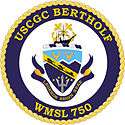USCGC Bertholf
.jpeg) USCGC Bertholf (WMSL-750) | |
| History | |
|---|---|
| Namesake: | Commodore Ellsworth P. Bertholf, USCG |
| Ordered: | January 2001 |
| Builder: | Northrop Grumman Ship Systems, Pascagoula, Mississippi |
| Cost: | $641 million[1] |
| Laid down: | March 29, 2005 |
| Launched: | September 29, 2006 |
| Christened: | November 11, 2006 |
| Commissioned: | August 4, 2008 |
| Homeport: | Integrated Support Command Alameda |
| Motto: | "Legends Begin Here" |
| Status: | Commissioned |
| Badge: |
 |
| General characteristics | |
| Type: | National Security Cutter |
| Displacement: | 4500 LT |
| Length: | 418 feet (127.40 meters) |
| Beam: | 54 feet (16.46 meters) |
| Draft: | 22.5 feet (6.86 meters) |
| Propulsion: |
|
| Speed: | 28+ knots |
| Range: | 12,000 nm |
| Complement: | 113 (14 Officers) |
| Sensors and processing systems: |
|
| Electronic warfare & decoys: | |
| Armament: |
|
| Aircraft carried: | (2) MH-65C Dolphin MCH, or (4) VUAV or (1) MH-65C Dolphin MCH and (2) VUAV |
| Aviation facilities: | 50x80 foot flight deck, hangar for all aircraft |
USCGC Bertholf (WMSL-750) is the first Legend-class maritime security cutter of the United States Coast Guard. She is named for Commodore Ellsworth P. Bertholf, fourth Commandant of both the Revenue Cutter Service and Coast Guard.
In 2005, construction began at Northrop Grumman's Ship Systems Ingalls Shipyard in Pascagoula, Mississippi. She was launched on September 29, 2006,[3] christened November 11, 2006,[4] and commissioned on August 4, 2008. The cutter's home port is Alameda, California. Bertholf was the first to fire the Bofors 57 mm gun aboard a U.S. vessel on the 11th of February 2008.
Operational History
On March 3, 2016, Bertholf responded to a sighting off the Pacific Coast of Panama of a semi-submersible narco-submarine, reported by a P-3 Orion.[5] The semi-submersible surrendered to a boarding party launched from Bertholf, and four suspects were captured along with 6 tons of cocaine.[6] The boarding party then sunk the semi-submersible.[7]
National Security Cutter
Bertholf is the lead ship of the National Security Cutter design and the first large ship to be built under the Coast Guard's multi-year Deepwater acquisitions project. The NSCs are to replace the fleet's aging 1960s 378-foot Hamilton-class cutters.
Features
- Automated weapon systems
- Medium-caliber deck gun (57 mm) capable of stopping rogue merchant vessels far from shore[8]
- Helicopter launch and recovery pad with rail-based aircraft retrieval system and two aircraft hangars
- Stern boat well for small boat launch and recovery
- Bow thruster
- State-of-the-art C4ISR improving interoperability between Coast Guard and Department of Defense assets[9]
- Detection and defense capabilities against chemical, biological, or radiological attack
- Advanced sensors for intelligence collection and sharing
- Real-time tracking and seamless common operational picture/maritime domain awareness via integration with Rescue 21
- Advanced state-of-the-art Ships Integrated Control System (machinery control, steering, navigation) for reduced manpower requirements and improved automation
- Cassidian (EADS) TRS-3D/16-ES air search radar for area surveillance[10]
- The cutter can have a anti-terrorism/force protection suite that will include underwater sonar that will allow the cutter to scan ports, approaches, facilities and high-value assets for underwater mines and minelike devices and detect swimmers.
Deepwater Controversy
The Deepwater program was subjected to public scrutiny in late 2006 and early 2007 following reports of overspending and design flaws. Specifically, the issues with Bertholf relate to the projected life of the ship. Originally the Coast Guard had expected the cutter to be a single-crew vessel, and spend a normal amount of time in port and underway. However, the US Coast Guard decided to implement a multi-crew system, similar but distinct to what the US Navy uses on its ballistic missile submarines. Rather than the Navy's system of two crews sharing a single hull, the CG multi-crew concept involve both multiple crews and multiple hulls. The addition of the multi-crewing enables the ship to spend more time at sea each year, but also decreases the expected lifespan of the vessel from 30 years to 20 years.
References
- ↑ USCG National Security Cutters: Bad News, Good News
- ↑ Dieselmann Wordpress
- ↑ Integrated Coast Guard Systems - Deepwater Program Official Website Archived September 28, 2007, at the Wayback Machine.
- ↑ USCG: Acquisition Directorate (CG-9)
- ↑ http://www.marinelog.com/index.php?option=com_k2&view=item&id=10761:video-coast-guard-intercepts-narco-submarine&Itemid=230
- ↑ http://www.foxnews.com/us/2016/03/29/california-us-coast-guard-crew-seizes-cocaine-off-panama.html
- ↑ http://www.navytimes.com/story/military/2016/03/28/coast-guard-cutter-busts-fifth-cocaine-sub-less-than-year/82346182/
- ↑ "Maritime Security Cutter, Large (WMSL)". Globalsecurity.org. Retrieved 25 November 2016.
- ↑ National security cutter approved for classified operations
- ↑ http://www.cassidian.com/cassidian/int/en/business-activities/naval-systems/sensors/TRS-3D-MSSR-2000I.html
External links
| Wikimedia Commons has media related to USCGC Bertholf (WMSL-750). |
- Bertholf home page
- Deepwater Official site about USCGS Bertholf
- National Security Cutter Home
- Team Deepwater NSC Home
- Bertholf intercepting drug boats in her first action (video)